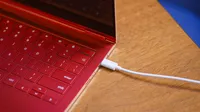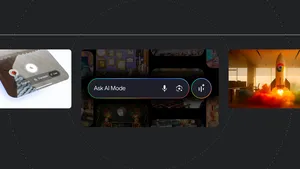This is the sound you will hear when a Chromebook has a lot of battery left and you plug in the charging cord.
Hear that? How we developed the charging sound for ChromeOS

What does ChromeOS sound like? It’s a trick question — because until recently, the operating system powering Chromebooks hasn’t actually sounded like anything at all.
Unlike Android or most other desktop operating systems, there have been no system sounds in ChromeOS: No noise when you empty the trash, when you move a file to a folder or adjust the volume.
But that changed in September 2023, when we added audible effects you'll hear when you plug in a charging cable or when your battery drops too low. And they could be just the first notes of an oncoming symphony.
“A charger is something that's used day in and day out, so the new sounds have the opportunity to become the basis of ChromeOS’s sound presence,” says Josh Ellis, a senior user experience (UX) sound designer. Additionally, audio cues for charge levels can aid in accessibility for blind and low-vision users by making it easier to ascertain relative battery life without needing to check with a screen reader first.
Bringing ChromeOS to sonic life was a major effort, requiring collaboration between our UX sound designers and our software engineers. First, they needed to craft the unique sounds for ChromeOS’s charging, and then actually implement them in a way that works across the wide range of Chromebooks.
But even before that, they had to decide: What should the operating system sound like?
“From the beginning, I felt it was important to build on the existing foundation that we already have at Google, specifically the charging sounds for Pixel phones,” says Henry Daw, the senior UX sound designer who helped create the new charging sounds. “It’s this faded-in piano that plays a nice G major chord.”

“I actually recreated that piano sound itself, but with more low frequency content to take advantage of the robust bass sound that the larger speakers on a ChromeOS device support,” he says. “I also wanted to add a tactile quality — as if it’s some kind of naturally occurring sound. For this, I added a super subtle layer of what I call ‘sparkle dust,’ which is actually based on white noise. And then we added small iterations based on what we were trying to communicate about the battery and charge level.”
With the sounds developed, the ChromeOS engineering team was ready to start adding them to the operating system. “These are the first sounds that we have implemented, so we needed to build a framework for the operating system to be able to play them,” says Erol Bicioglu, a Chrome software engineering manager. This meant the team needed to make sure the files were small enough while also sounding crisp and clear. But there was one problem from the start: the files were too big.
The team decided to use FLAC, an open-source format which maintains the original quality of the audio while still allowing the file to be shrunk down to a smaller size — which meant the team also needed to expand the existing audio capabilities in ChromeOS to support playing the new FLAC format, ensuring that the new sound would work on different devices, no matter the hardware.
Once all that was done, all that was left to do was to hook those newly playable sounds into the rest of the operating system to match the battery level.
Now when your Chromebook is plugged in and the battery is already above 80%, you’ll hear the new sparkle-dusted charging sound. And when the battery drops below 15 minutes of remaining charge, you’ll hear a familiar triple-note chime reminding you to plug in your charger.
Your browser does not support the audio element.
This is the sound you will hear when your Chromebook's battery is running out.
Henry also devised two additional variants of the new charging sound to help provide contextual information about the battery life from the second you plug it in. “When the battery is between 16% and 79% full, you’ll hear a variation on the charging sound, which includes an additional element that’s almost like a cheerful ‘swoop,’ at the start of the sound, indicating that the battery is kind of at a medium level,” says Henry.
A third variation — for when the battery is below 15% — includes a similar additional swooping sound at the start, but it’s slightly higher-pitched and more noticeable. “Kind of like the computer saying, ‘Phew, thanks. I really needed that,’” Henry says.
All this effort for a single set of charging sound effects may seem like a lot, but the team is starting off small intentionally. “We didn't want to come in out of the gates with a huge amount of new sounds because ChromeOS users aren’t used to having sound, so we wanted to start out subtly,” Josh says. Plus, since Chromebooks are heavily used in educational settings by teachers and students, the team was very focused in making sure sound and volume were helpful and not distracting.
The team also mentions that based on early user feedback, they tweaked settings so that the charge sound is off by default for existing users but on for new users — and anyone can head to their settings and change this whenever they want.
Thanks to the team’s intentional work creating this framework, ChromeOS is ready for any additional sounds the team may want to add down the line. So keep your eyes — er, ears — open.






